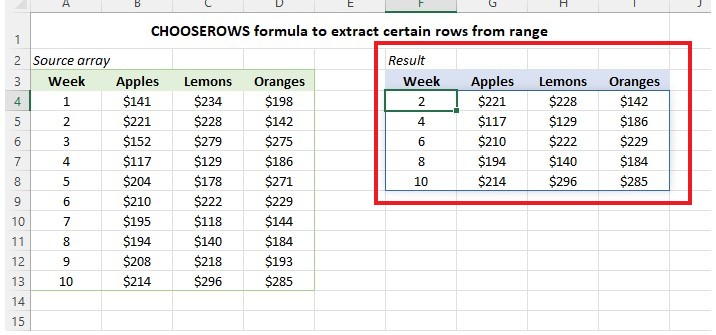The Simplest Guide : How To Use Excel CHOOSEROWS Function
Jun 04, 2023
Do you want to learn how to use the Excel CHOOSEROWS function?
This feature can be useful when you want an efficient way to extract specific information from a data set. Moreover, the CHOOSEROW function can sort through thousands of rows of data in just moments. This way, you can quickly select whatever rows match your criteria.
Read on as we cover the following:
-
What Is the Excel CHOOSEROWS Function?
-
How to use the CHOOSEROWS Function in Excel
-
CHOOSEROWS Function Issues
-
Final Thoughts on How to Use the Excel CHOOSEROWS Function
-
Frequently Asked Questions on How to Use the Excel CHOOSEROWS Function
What Is Excel CHOOSEROWS Function?
The CHOOSEROWS function returns specific rows from an array or range by providing their row numbers as separate arguments.
The row number corresponds to the numeric index of the desired rows in the given array.
CHOOSEROWS function syntax
=CHOOSEROWS(array, row_num1, [row_num2], ...)CHOOSEROWS function arguments
-
Array - the source array to extract rows from.
-
Row_num1 - an integer that represents the numeric index of the first row to return.
-
Row_num2 - the index numbers of extra rows to return.
How to Use the CHOOSEROWS Function in Excel
To extract specific rows from a given array, use the CHOOSEROWS formula in this manner:
-
To create an array, you can provide either a cell range or an array of values generated by another formula.

-
For row_num, get a number that is either positive or negative. This number will tell you which row to get back.

Note: A positive value returns a corresponding row from the beginning of the array, and negative values - from the ending of a range or array.
Multiple row numbers are provided individually in single or separate arguments as an array constant.
CHOOSEROWS is an Excel function that handles arrays natively. To use it, input the formula at the upper-left part of the cell range you want to output.
The formula will automatically spill into additional columns and rows to create a single dynamic array or spill range.
Retrieve rows with the Excel CHOOSEROWS function.
To retrieve rows 2, 4, 6, 8, and 10 from the range A4:D13, follow the steps below:

-
Choose an empty cell, enter the Excel formula bar, and type your CHOOSEROWS formula.

-
Press Enter to get the result.

You can also give the row numbers by typing them in different cells. Then, you can use those cell references for multiple-row numbers or a range reference for one-row numbers.

Using this approach, you can easily retrieve different rows by changing the numbers in the predetermined cells without modifying the formula.

CHOOSEROWS Function Issues
These are the most common reasons the CHOOSEROWS formula may result in an error.
-
The #VALUE! error appears when the value of the row_num argument is zero or exceeds the sum number of rows in the array.
-
The #NAME? An error appears when you misspell the function's name.
-
The #SPILL! error happens when insufficient blank cells display the results. The solution to this problem is to remove the cells blocking it.
Final Thoughts on How to Use Excel CHOOSEROWS Function
The Excel CHOOSEROWS function can help when you have a lot of data to process.
It will filter out rows that are not important and make sure to only include the right information. Moreover, the CHOOSEROWS function makes it easier to analyze your data.
Visit Simple Sheets for more easy-to-follow guides, and remember to visit the related articles section of this blog post.
For the most straightforward Excel video tutorials, subscribe to Simple Sheets on Youtube!
Frequently Asked Questions on How to Use Excel CHOOSEROWS Function
Why can't I use the CHOOSEROWS function in Excel 2019 version?
The CHOOSEROWS function is exclusive to Microsoft 365 and the web version of Excel.
How do I get the end value rows from a range quickly?
To count rows from the end of the array, input negative numbers for the 'row_num' argument, which applies to all arrays.
How can I swap an array vertically from the top to the bottom?
Use the CHOOSEROWS and SEQUENCE Excel functions together, and set only SEQUENCE's first argument (rows) to equal the total number of rows in the initial array rows.
Related Articles:
Everything You Need To Learn About The Pivot Table In Excel
Want to Make Excel Work for You? Try out 5 Amazing Excel Templates & 5 Unique Lessons
We hate SPAM. We will never sell your information, for any reason.



